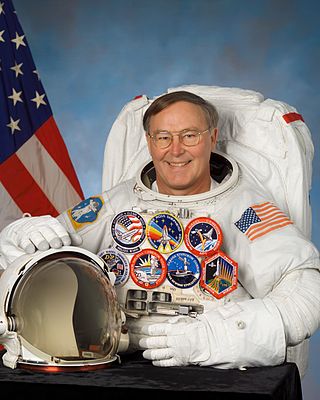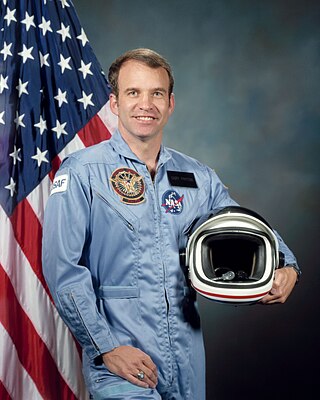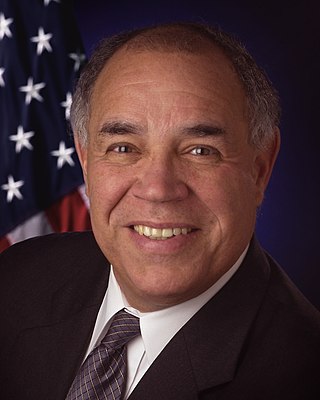
Jerry Lynn Ross is a retired United States Air Force officer, engineer, and a former NASA astronaut. Ross is a veteran of 7 Space Shuttle missions, making him the joint record holder for most spaceflights.

Henry Warren Hartsfield Jr. was a United States Air Force Colonel and NASA astronaut who logged over 480 hours in space. He was inducted into the United States Astronaut Hall of Fame in 2006.

Richard Michael Mullane is an engineer and weapon systems officer, a retired USAF officer, and a former NASA astronaut. During his career, he flew as a mission specialist on STS-41-D, STS-27, and STS-36.

Colonel Gary Eugene Payton, USAF, is an American astronaut and USAF Manned Spaceflight Engineer. Payton flew on the STS-51-C mission aboard the Space Shuttle Discovery in January 1985. He later served as Deputy Undersecretary of the Air Force under the Bush and Obama Administrations.

Richard Oswalt Covey is a retired United States Air Force officer, former NASA astronaut, and a member of the United States Astronaut Hall of Fame.

Curtis Lee "Curt" Brown Jr. is a former NASA astronaut and retired United States Air Force colonel.

Daniel Charles Brandenstein is the Executive Vice President and Chief Operating Officer of United Space Alliance. He is a former Naval Aviator, test pilot and NASA astronaut, who flew four Space Shuttle missions. He also served as Chief of the Astronaut Office from 1987 to 1992.

Michael Allen Baker is a retired captain in the United States Navy, former NASA astronaut, and the International Space Station Program Manager for International and Crew Operations, at NASA's Johnson Space Center. He is responsible for the coordination of program operations, integration and flight crew training and support activities with the International Partners.

Robert Donald Cabana is the Associate Administrator of the National Aeronautics and Space Administration (NASA), a NASA astronaut, and a veteran of four Space Shuttle flights. He served as Chief of the Astronaut Office from 1994 to 1997 and as director of the John F. Kennedy Space Center from 2008 to 2021. He is also a former naval flight officer and naval aviator in the United States Marine Corps.

Brian Duffy is a retired U.S. Air Force colonel and a former NASA astronaut. He flew aboard four Space Shuttle missions.

Ronald John Grabe, , is a former NASA astronaut.

Sidney McNeill Gutierrez, is an American pilot and former NASA astronaut. Since retiring from NASA, Gutierrez has worked in several leadership positions at Sandia National Laboratories and Rocket Crafters Inc.

Frederick Drew Gregory is a former United States Air Force pilot, military engineer, test pilot, and NASA astronaut as well as former NASA Deputy Administrator. He also served briefly as NASA Acting Administrator in early 2005, covering the period between the departure of Sean O'Keefe and the swearing in of Michael D. Griffin.

Lloyd Blaine Hammond Jr. is a Gulfstream test pilot, a former United States Air Force officer, and a former NASA astronaut. He flew on two Space Shuttle missions.

Thomas David Jones is a former United States astronaut. He was selected to the astronaut corps in 1990 and completed four Space Shuttle flights before retiring in 2001. He flew on STS-59 and STS-68 in 1994, STS-80 in 1996, and STS-98 in 2001. His total mission time was 53 days 48 minutes. He works as a planetary scientist, space operations consultant, astronaut speaker, and author.

Kevin Richard Kregel is an American former astronaut, and former member of the Space Launch Initiative Project at the Lyndon B. Johnson Space Center.

Steven Wayne Lindsey is a retired U.S. Air Force officer and NASA astronaut. Lindsey served as Chief of the NASA Astronaut Office from September 2006 until October 2009.

Carl Joseph Meade is a former NASA astronaut.

Steven Ray Nagel, , was an American astronaut, aeronautical and mechanical engineer, test pilot, and a United States Air Force pilot. In total, he logged 723 hours in space. After NASA, he worked at the University of Missouri College of Engineering as an instructor in its Mechanical and Aerospace Engineering Department.

Carl Erwin Walz is a retired NASA astronaut currently working for Orbital Sciences Corporation's Advanced Programs Group as vice president for Human Space Flight Operations. Walz was formerly assigned to the Exploration Systems Mission Directorate at NASA Headquarters in Washington, D.C. He was the Acting Director for the Advanced Capabilities Division in the Exploration Systems Mission Directorate, and was responsible for a broad range of activities to include Human Research, Technology Development, Nuclear Power and Propulsion and the Lunar Robotic Exploration Programs to support the Vision for Space Exploration.
























